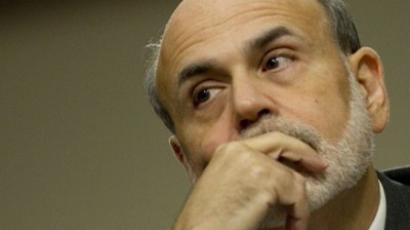Federal Reserve predicts new economic crisis

A recent meeting of the US Federal Reserve revealed that members of America’s central bank are not very optimistic about the future of the country’s economy.
Even though the Fed is at odds regarding what to do in terms of helping economic growth — and it still remains unclear whether or not a third round of quantitative easing (QE3) is to come — the official forecast from the bank suggests that the US may be sliding into a crisis.Details from the Fed’s last meeting have been released to the public, and the minutes from that gathering reveal that the economists that oversee much of the inner-workings of the country’s fiscal policy remain concerned with the state of America. Among the items discussed in the meeting ishow a lack of initiative on the part of the US Congress could bring further strain on America’s economy, specifically that a failure to avert tax hikes and planned massive spending cuts later this year could be catastrophic.The Fed has also downgraded its economic forecast, citing that a stagnant job market continues to cause problems. The minutes also reveal that the Fed’s board believes that the unemployment epidemic that has plagued the Obama administration since the current president took office in 2009 shows no sign of shaping up — members forecast that statistics for the next few months will mirror the current unemployment level of 8.2 percent.Federal Reserve Chairman Ben Bernanke has been critical of US jobs statistics throughout his tenure with the bank. Even still, though, the Fed has shown little action in recent times when it comes to offering a helping hand. "This unemployment situation we have, the jobs situation, is really a national crisis," Bernanke said all the way back in April 2011 while speaking in Ohio. The chairman told Congress around the same time that "The Committee will continue to closely monitor economic developments and is prepared to take further action as appropriate to promote a stronger economic recovery in the context of price stability.” One year later, though, the Fed seems still unsure about what to do.Further steps “could be warranted,” several Fed members agree. How, when and what the bank will do remains a mystery, though, in an issue that is complicated, to say the least. Even if some members are for considering options that may include another round of quantitative easing, the Fed is mostly divided when it comes to a possible plan of action."These minutes show that there is still a very deep division within the Fed," DMJ Advisors’ chief economist, David Jones, tells the Associated Press about the bank’s latest report. As news of their last meeting has made it outside of Washington, the Dow Jones Industrial Average was down on Wednesday for its fifth straight day of losses. The price of gold has also declined yet again, a matter which the Wall Street Journal’s MarketWatch suggests is a result of the release of the Fed’s meeting minutes.Although minutes from the Fed’s last meeting are just being made public, that isn’t to say that it’s a late breaking issue. Records from the last sit-down among the Fed’s board members date to a June 19-20 meeting, with details about what — if any — discussions that have occurred in the three weeks since being a mystery. The Fed is not expected to hold another meeting until the end of this month, which will then be followed by a gathering on September 12-13. “It seems as though the committee is moving away from quantitative easing as the central bank expects the economic activity to gradually gather pace over the coming months,” David Song, a currency analyst at DailyFX, adds to MarketWatch.“Although theFed kept the door open to expand monetary policy further, the recent rhetoric suggests that QE3 will be taken off the table as members of the board float the idea of looking at ‘new tools’ to strengthen the tepid recovery.”The minutes also reveal that 15 members of the Federal Open Market Committee had a poor outlook about America’s economy as of their last meeting, up from April’s figure of just eight.














